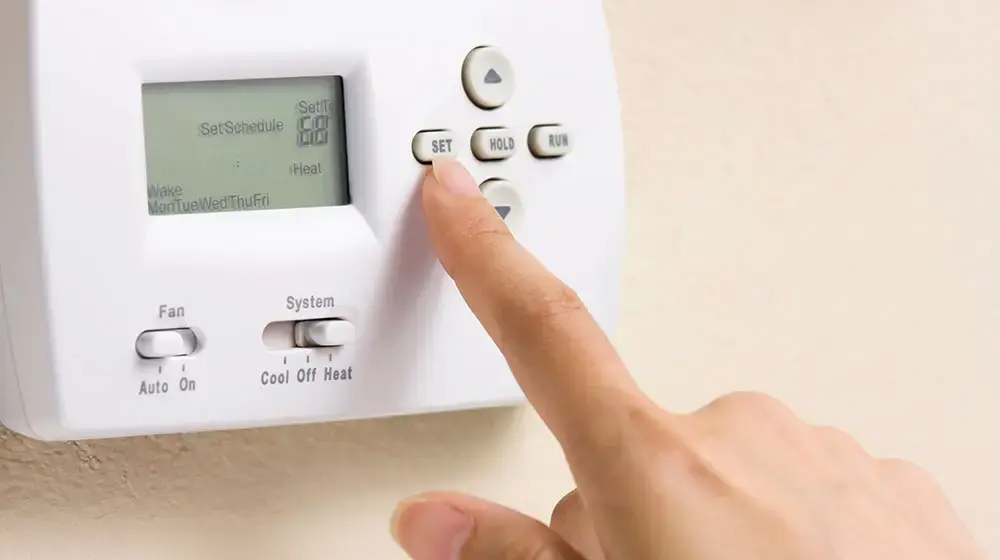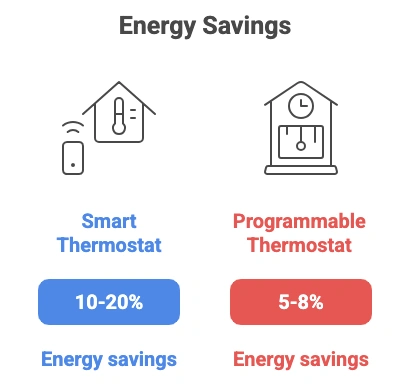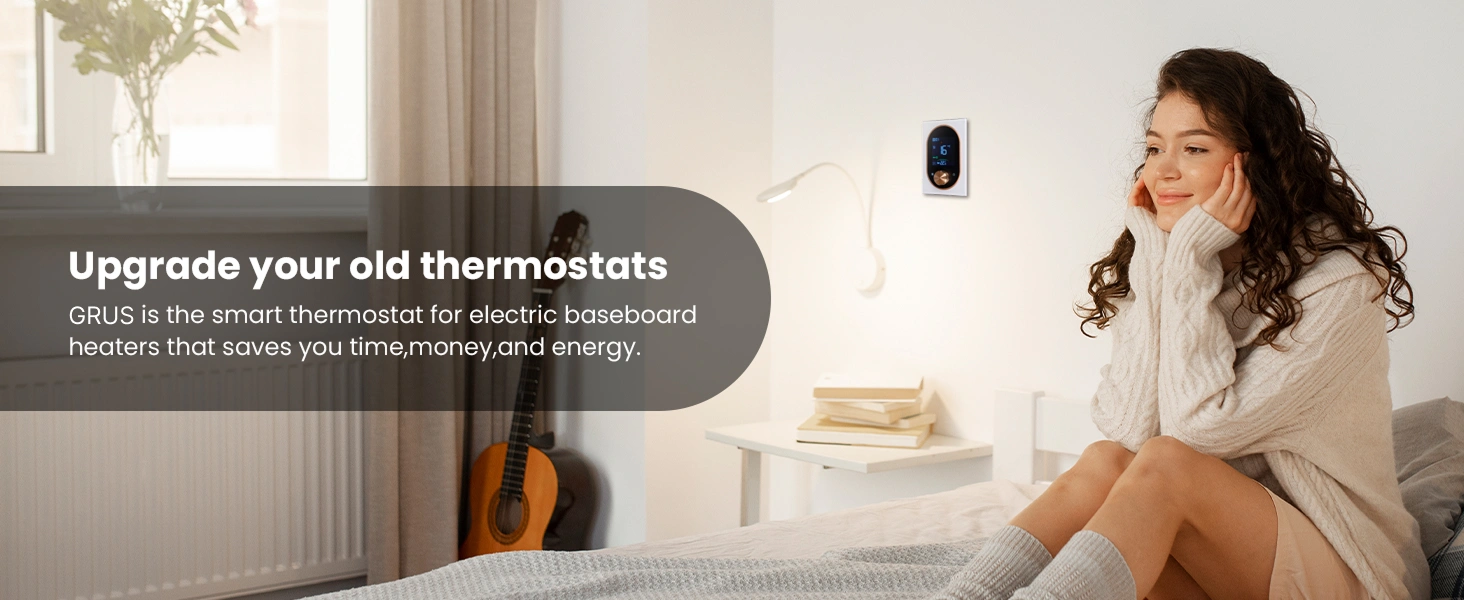When it comes to choosing between a programmable vs smart thermostat, many homeowners with baseboard heaters wonder if the upgrade is really worth it. If you already use a programmable model, you’re ahead of most — but as energy costs rise, a smart thermostat could take you the rest of the way.
You’ve taken that first step toward saving energy — but as utility bills keep climbing, you might be wondering: Would switching to a smart thermostat actually make a difference?
It’s a fair question. Programmable thermostats have been around for decades, and they work just fine. But modern smart thermostats promise more comfort, more control, and better savings. Are they truly worth upgrading for? Let’s look at how both types work, how much they really save, and which one fits your home best.
1. Why Many Homeowners Outgrow Their Programmable Thermostats
Programmable thermostats were designed to help homeowners save by scheduling heat around daily routines. You set a weekly schedule — warm in the morning, lower while you’re at work, cozy again by evening. In theory, it’s perfect.
In reality, life isn’t that predictable anymore. Between hybrid work, weekend plans, or kids’ activities, few families actually stick to fixed schedules. And that’s where things fall apart.
“I had a basic Honeywell for years,” one user wrote. “It worked fine — until my routine started changing. Then I was constantly reprogramming it or forgetting to change the schedule. My ‘automatic’ system became completely manual.”

If your thermostat is still following an outdated schedule, you’re probably wasting energy without realizing it. Many households eventually give up adjusting altogether and just keep one temperature all day.
So yes, programmable thermostats can be energy saving thermostats — but only if you keep programming them. And let’s be honest, most of us don’t have the patience for that every week.
2. What Makes a Thermostat Truly “Smart”
Smart thermostats go beyond timers and manual schedules. They learn, adapt, and optimize automatically.
Here’s what that means in practice:
- Wi-Fi and App Control – You can check or adjust the temperature from anywhere using your phone. No need to run downstairs or back home to turn the heat off.
- Learning Mode – The thermostat recognizes your patterns over time, adjusting heat automatically for your comfort while minimizing waste.
- Geofencing – When you leave home, the temperature drops automatically. When you’re heading back, it warms up again before you arrive.
- Voice Control – Works with Alexa and Google Home, so you can say, “Turn the heat down to 68.”
- Energy Reports – Many smart thermostats track usage, helping you see exactly when and where energy is wasted.
Unlike programmable thermostats that need your input, smart models handle the details for you. You stop guessing — and your system starts saving.
For homeowners using electric baseboard heaters, products like the EcoNet-BH Smart Thermostat bring these same intelligent features to high-voltage heating systems.
“It’s one of those small upgrades that actually changes how you live,” said another reviewer. “Now I can check every room’s temperature from my phone, even at the cabin.”
That convenience quickly turns into real energy efficiency.
3. Real-World Energy Savings: Facts Over Marketing
Let’s cut through the marketing numbers and talk facts.
According to the U.S. Department of Energy, properly using a programmable thermostat can save around 5–8% on heating and cooling bills. A smart thermostat, by comparison, typically saves 10–20% per year.
It might sound small, but consider the average North American household spends $800–$1,200 a year on heating. A 15% reduction equals around $120–$180 in savings every winter — enough to pay for the upgrade within one to two seasons.

Here’s a quick breakdown:
| Feature | Programmable | Smart |
|---|---|---|
| Control | Fixed daily schedules | App, learning, geofencing |
| Energy Reports | ❌ None | ✅ Detailed usage reports |
| Savings (avg.) | 5–8% | 10–20% |
| Ease of Use | Manual reprogramming | Fully automatic |
| Convenience | Basic | High |
Those savings come from fewer wasted hours of heat when no one’s home, plus better temperature consistency. You won’t find yourself roasting one room and freezing in another just because the schedule didn’t match your day.
In short: smart thermostats don’t just save electricity — they save attention. Once set up, they quietly work in the background to cut waste every day.
4. Is a Smart Thermostat Right for Your Baseboard Heaters?
Here’s where it gets important: not every smart thermostat is compatible with baseboard heating.
Most of the popular models you see at big box stores (like Nest or Ecobee) are built for low-voltage furnace systems — not line-voltage electric heaters. If you connect the wrong type, it won’t work properly or could even be unsafe.
Before upgrading, check three things:
- Voltage: Baseboard heaters usually run on 120 V or 240 V circuits.
- Wiring: Make sure your existing thermostat has two or four thick wires — that’s a sign it’s line-voltage.
- Compatibility: Choose a smart baseboard heater thermostat designed specifically for this type of system.
That’s where EcoNet-BH comes in. It’s built for electric baseboard and radiant heating systems common in older and modern North American homes alike.
It connects via Wi-Fi (Grus App), supports Alexa and Google Home voice control, and includes six programmable periods per day — giving you the flexibility of a programmable thermostat, plus the intelligence of a smart one.
“We installed the EcoNet-BH upstairs last winter,” said one customer. “Finally, the rooms stay warm when we’re home and cool when we’re not — and I can see the energy difference right on my phone.”
That’s the kind of convenience you can feel — and measure.
5. Why the Upgrade Makes Sense Beyond the Numbers
For many homeowners, the real value isn’t just saving on heating bills — it’s comfort and peace of mind.
Smart thermostats let you:
- Check your home temperature from miles away;
- Warm up a room before you arrive;
- Keep an eye on energy usage in real time;
- Maintain consistent comfort across multiple zones.
They’re especially practical for:
- Vacation homes or rentals – remote control prevents energy waste when unoccupied;
- Upstairs bedrooms or basements – manage uneven heat zones easily;
- Busy families – “set and forget” automation fits unpredictable schedules.
With more homeowners moving toward smart energy efficiency, the upgrade isn’t about luxury — it’s about future-proofing your comfort and cutting avoidable waste.
EcoNet-BH — Smart Control Made for Baseboard Heaters
If your home relies on baseboard heaters, EcoNet-BH is purpose-built for you.
- Designed for 120/240 V line-voltage systems
- Supports Wi-Fi app control through Tuya Smart
- Works with Alexa & Google Home
- Includes 6-period programmable scheduling
- Has energy-saving and manual modes
- Requires no central hub and installs easily
Whether it’s your main residence, a rental unit, or a lakeside cottage, EcoNet-BH gives you the flexibility to stay warm efficiently — without wasting a single watt.
Explore full specs and installation tips on the EcoNet-BH Smart Baseboard Heater Thermostat.
Conclusion: When Convenience and Efficiency Meet
If your programmable thermostat still works, there’s no rush to toss it out. But if you want a system that adjusts automatically, learns your habits, and finally helps you see your energy savings, upgrading to a smart thermostat is a simple and rewarding move.
For baseboard heater homes especially, the difference is night and day — fewer wasted hours, lower bills, and a home that’s always the right temperature when you walk in.
Ready for a cozier, more efficient home?
See how EcoNet-BH Smart Baseboard Heater Thermostat helps you stay warm, save more, and simplify comfort this winter.
If you’d like to see how smart temperature control fits into a whole-home system, visit our Remote Temperature Control Solution.
FAQ
Do smart thermostats really save more energy than programmable ones?
Yes — studies from the U.S. Department of Energy show smart thermostats can save around 10–20% on heating and cooling costs each year. They automatically adjust temperatures when you’re away, which prevents energy waste most programmable models can’t detect.
Can I use a smart thermostat with electric baseboard heaters?
Not every smart thermostat works with baseboard systems. Most popular models like Nest or Ecobee are built for low-voltage HVAC systems. For electric baseboards (120V or 240V), look for a smart baseboard heater thermostat made for line-voltage, which connects directly and safely.
Is upgrading from a programmable to a smart thermostat really worth it?
If your goal is lower heating bills and less daily hassle, yes. Smart thermostats save energy automatically, show real-time usage data, and give you remote control through your phone or voice assistant. Most homeowners recover the cost within a winter or two.

Comments
Post a Comment